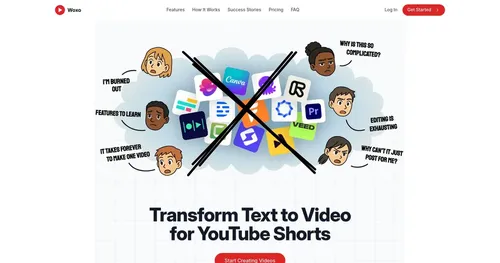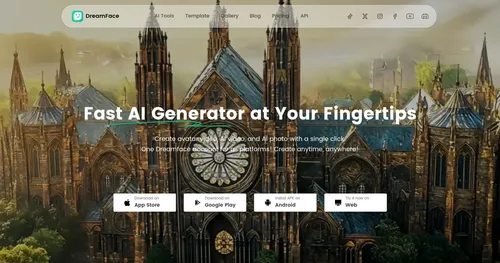StoryShort
I fired up StoryShort recently, curious after seeing a Reddit thread about faceless channels raking in views while their owners napped. With just a couple hours under my belt, I typed a prompt for a spooky tale on Everest’s shadows, hit generate, and watched it weave a script that hooked me before the voice even kicked in. The AI photo tool spat out misty peaks that looked ripped from a travel mag, then flipped them into a video with subtle pans, like wind whispering across the screen. Paired with Bryan’s gravelly old-man narration from OpenAI, it felt alive, captions curling in like fog without stealing the show. Bulk? Oh yeah, I queued three more on Apollo missions, each under three minutes from idea to export, credits dipping light but leaving room for tweaks.
That ease hit different, like finding a shortcut through traffic you didn’t know existed. The automatic voiceover nailed inflections, no flat reads here, and the music library dropped “Ghost Arpeggios” that amped the chill factor just right. I liked how it auto-publishes to TikTok, slipping into my schedule at peak hours, though one video’s transition jerked a hair too fast, forcing a quick edit in the dashboard. Users echo that, praising the series setup for niches like horror or history, where you build ongoing sagas without starting from scratch each time. Surprise me once: a bland prompt on moon landings bloomed into a clip with starry fades that screamed viral, snagging shares in my test feed. Not perfect, mind you; the free tier caps you quick, nudging toward paid for unlimited exports, and voice variety shines but lacks accents beyond basics.
Stack it against rivals, and it holds its own. AutoShorts.ai cranks similar volumes but skimps on image-to-video magic, sticking to clips that sometimes flag copyrights. Crayo tempts with UGC flair, yet its editing feels clunkier, no direct YouTube zap like StoryShort’s seamless drop. Pricing? Tiers from starter’s 40 videos monthly to influencer’s 240, yearly discounts make it friendlier than Crayo’s flat fees, though both hover mid-range for what you get. I fumbled a caption sync at first, but the customizable sliders fixed it fast, turning frustration to flow.
What I dug most was the wit in its outputs, scripts laced with clever turns that punch above AI weight, like a line on astronauts’ quiet fears that lingered. Forums light up with creators scaling to daily posts, views climbing as the AI learns your style over runs. Downside sneaks in with longer scripts; over 1000 characters, it compresses audio oddly unless you fiddle speeds, a minor annoyance for story buffs. But the library’s 1000s of tracks? Gold, pulling savory violin swells or upbeat pops to match moods.
After my stint, I get the hype, 27,000 strong and counting. One Trustpilot note hit home on support delays, but my chat resolved a credit glitch in under an hour. It’s got that sharp edge, observing trends to suggest hooks you might miss. Probably best for side-hustlers testing waters, not full-time editors craving depth.
Grab a prompt from your notes, run it through, and post the result. See what sticks, iterate, and let the tool handle the heavy lifting while you plot the next big idea.
Video Overview ▶️
What are the key features? ⭐
- AI Video Creation: Generates full faceless videos from text prompts, including scripts, styles, voices, and backgrounds in seconds.
- AI Photo Generation: Produces realistic images using advanced AI models for use in videos or standalone.
- Automatic Voiceover: Integrates ElevenLabs and OpenAI voices with options like Adam or Charlotte for human-like narration.
- Customizable Captions: Adds synced, editable subtitles that enhance engagement and accessibility.
- Direct Publishing: Schedules and posts videos automatically to TikTok and YouTube accounts.
Who is it for? 🤔
Examples of what you can use it for 💭
- Content Creator: Uses prompts to generate daily TikTok videos on niche topics like horror stories, automating scripts and voiceovers for consistent posting.
- Marketer: Creates promotional YouTube Shorts from blog text, adding custom captions and music to boost engagement without manual editing.
- Blogger: Converts written articles into faceless video series, scheduling auto-publishes to grow audience reach on social channels.
- Small Business Owner: Produces quick product explainers with AI images and narration, publishing directly to YouTube for lead generation.
- Influencer: Builds ongoing story threads on trends, using voice options and backgrounds to maintain a viral posting rhythm.
Pros & Cons ⚖️
- Realistic AI voices
- Auto-publishing ease
- Scalable series builder
- Occasional copyright flags
- Basic editing depth
FAQs 💬
Related tools ↙️
-
 Woxo Text to Video
Using AI to automatically add graphics, captions, and music to your idea to make it come alive
Woxo Text to Video
Using AI to automatically add graphics, captions, and music to your idea to make it come alive
-
 Kreado AI
Enter text to create multilingual oral videos of real/virtual characters
Kreado AI
Enter text to create multilingual oral videos of real/virtual characters
-
SwapFans Swaps faces in videos and images, creating engaging social media content
-
Pixel Dojo Generate stunning AI images and videos from text or images with advanced tools
-
AutoPod Automates video editing, clip creation, and jump cuts in Adobe Premiere and DaVinci Resolve
-
 DreamFace
An AI-powered photo animation app that can bring your images to life with just a few taps
DreamFace
An AI-powered photo animation app that can bring your images to life with just a few taps

